Comprehensive Analysis of GDF SUEZ Financial Strategy and Performance
VerifiedAdded on 2020/06/04
|10
|2564
|183
Report
AI Summary
This report provides a detailed analysis of the financial strategy employed by GDF SUEZ. It begins by examining the company's capital structure, including an assessment of its debt-equity ratio and financial leverage, highlighting the advantages and disadvantages of debt financing. The report then delves into GDF SUEZ's working capital strategy, evaluating its short-term financial performance using current ratios and working capital calculations, and relating these findings to the accounting matching principle. The analysis reveals that the company has a high debt-equity ratio and a fluctuating working capital position, with the report discussing the implications of these financial characteristics. The report concludes by summarizing the key findings regarding GDF SUEZ's capital structure and working capital management, offering insights into the company's financial health and strategies for improvement. The analysis is supported by financial data from 2013 and 2014.
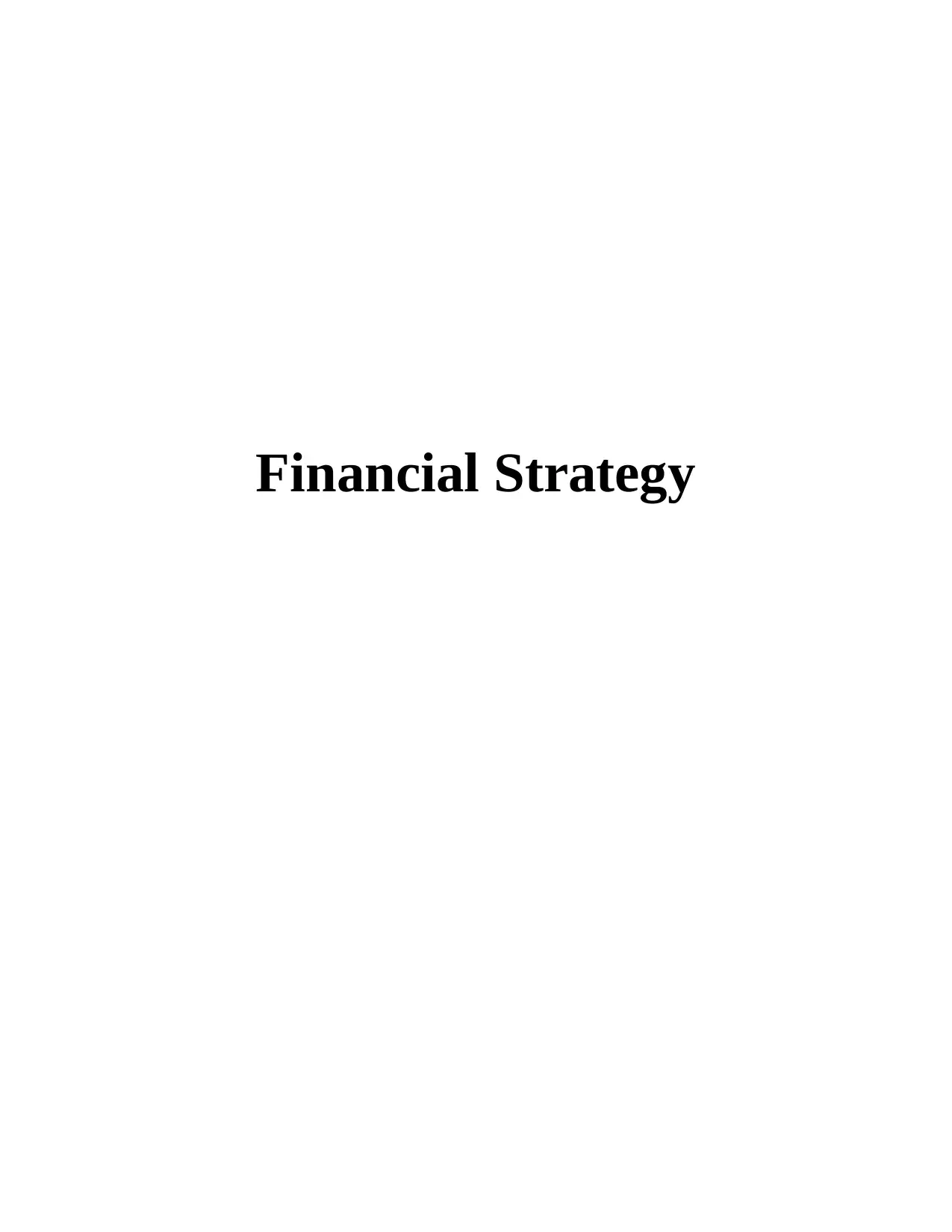
Financial Strategy
Paraphrase This Document
Need a fresh take? Get an instant paraphrase of this document with our AI Paraphraser
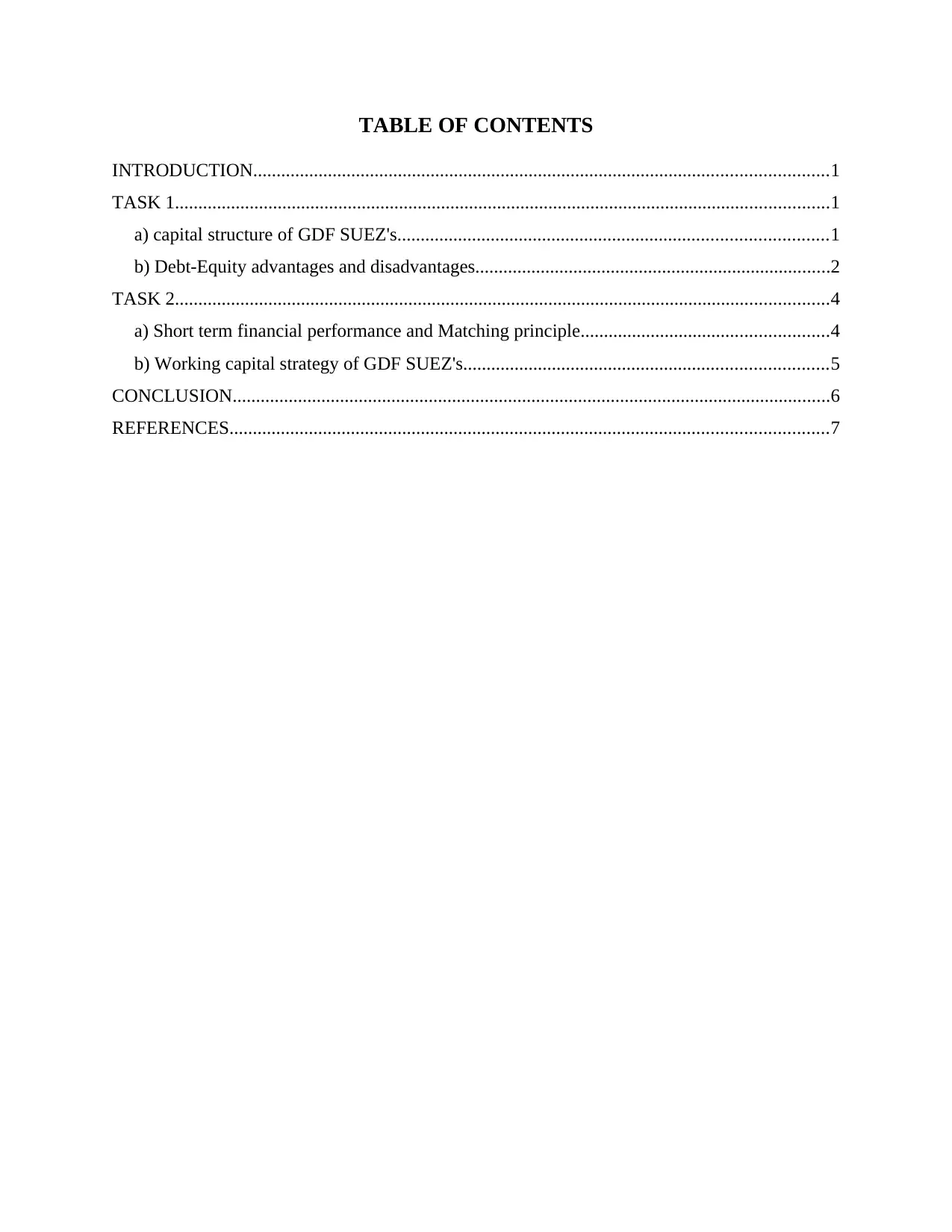
TABLE OF CONTENTS
INTRODUCTION...........................................................................................................................1
TASK 1............................................................................................................................................1
a) capital structure of GDF SUEZ's............................................................................................1
b) Debt-Equity advantages and disadvantages............................................................................2
TASK 2............................................................................................................................................4
a) Short term financial performance and Matching principle.....................................................4
b) Working capital strategy of GDF SUEZ's..............................................................................5
CONCLUSION................................................................................................................................6
REFERENCES................................................................................................................................7
INTRODUCTION...........................................................................................................................1
TASK 1............................................................................................................................................1
a) capital structure of GDF SUEZ's............................................................................................1
b) Debt-Equity advantages and disadvantages............................................................................2
TASK 2............................................................................................................................................4
a) Short term financial performance and Matching principle.....................................................4
b) Working capital strategy of GDF SUEZ's..............................................................................5
CONCLUSION................................................................................................................................6
REFERENCES................................................................................................................................7
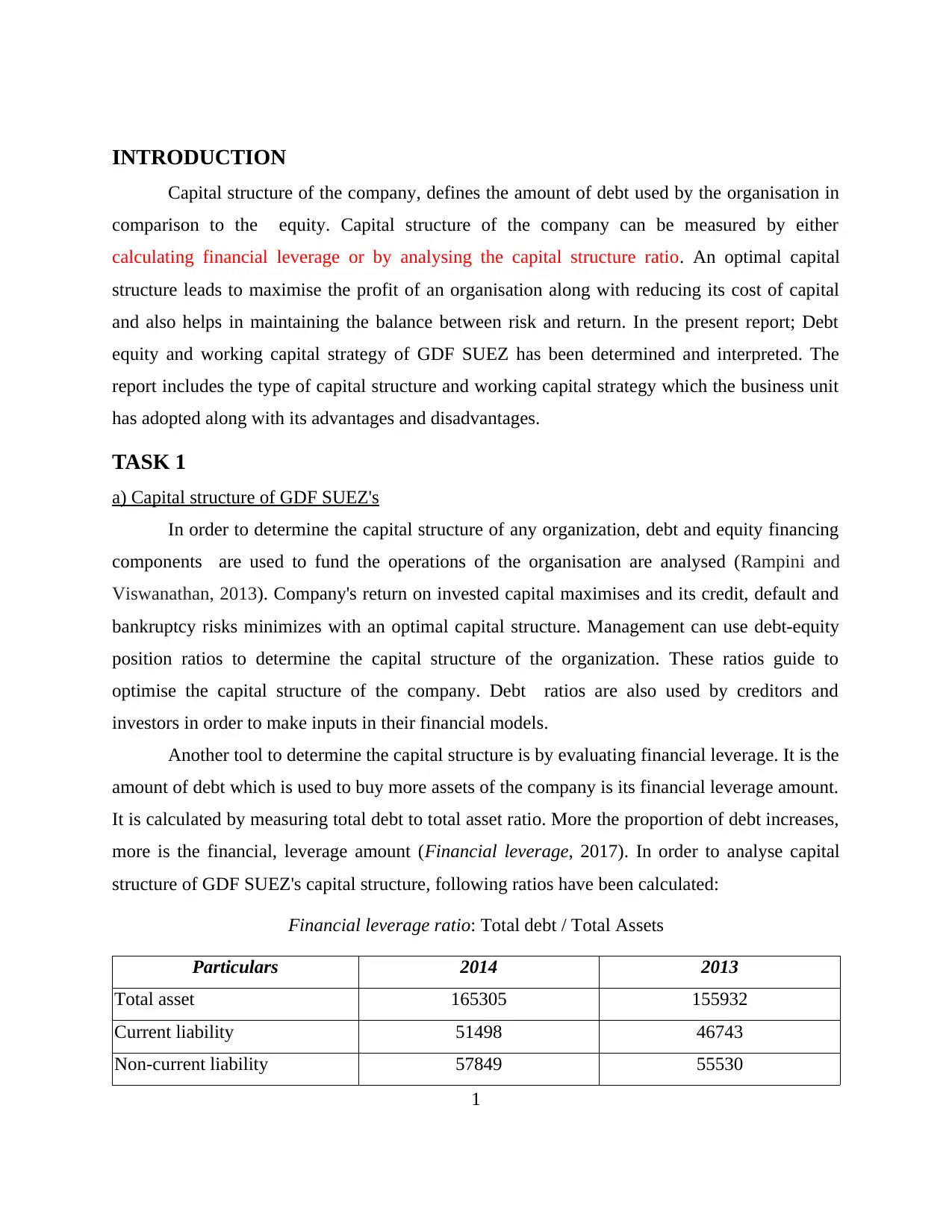
INTRODUCTION
Capital structure of the company, defines the amount of debt used by the organisation in
comparison to the equity. Capital structure of the company can be measured by either
calculating financial leverage or by analysing the capital structure ratio. An optimal capital
structure leads to maximise the profit of an organisation along with reducing its cost of capital
and also helps in maintaining the balance between risk and return. In the present report; Debt
equity and working capital strategy of GDF SUEZ has been determined and interpreted. The
report includes the type of capital structure and working capital strategy which the business unit
has adopted along with its advantages and disadvantages.
TASK 1
a) Capital structure of GDF SUEZ's
In order to determine the capital structure of any organization, debt and equity financing
components are used to fund the operations of the organisation are analysed (Rampini and
Viswanathan, 2013). Company's return on invested capital maximises and its credit, default and
bankruptcy risks minimizes with an optimal capital structure. Management can use debt-equity
position ratios to determine the capital structure of the organization. These ratios guide to
optimise the capital structure of the company. Debt ratios are also used by creditors and
investors in order to make inputs in their financial models.
Another tool to determine the capital structure is by evaluating financial leverage. It is the
amount of debt which is used to buy more assets of the company is its financial leverage amount.
It is calculated by measuring total debt to total asset ratio. More the proportion of debt increases,
more is the financial, leverage amount (Financial leverage, 2017). In order to analyse capital
structure of GDF SUEZ's capital structure, following ratios have been calculated:
Financial leverage ratio: Total debt / Total Assets
Particulars 2014 2013
Total asset 165305 155932
Current liability 51498 46743
Non-current liability 57849 55530
1
Capital structure of the company, defines the amount of debt used by the organisation in
comparison to the equity. Capital structure of the company can be measured by either
calculating financial leverage or by analysing the capital structure ratio. An optimal capital
structure leads to maximise the profit of an organisation along with reducing its cost of capital
and also helps in maintaining the balance between risk and return. In the present report; Debt
equity and working capital strategy of GDF SUEZ has been determined and interpreted. The
report includes the type of capital structure and working capital strategy which the business unit
has adopted along with its advantages and disadvantages.
TASK 1
a) Capital structure of GDF SUEZ's
In order to determine the capital structure of any organization, debt and equity financing
components are used to fund the operations of the organisation are analysed (Rampini and
Viswanathan, 2013). Company's return on invested capital maximises and its credit, default and
bankruptcy risks minimizes with an optimal capital structure. Management can use debt-equity
position ratios to determine the capital structure of the organization. These ratios guide to
optimise the capital structure of the company. Debt ratios are also used by creditors and
investors in order to make inputs in their financial models.
Another tool to determine the capital structure is by evaluating financial leverage. It is the
amount of debt which is used to buy more assets of the company is its financial leverage amount.
It is calculated by measuring total debt to total asset ratio. More the proportion of debt increases,
more is the financial, leverage amount (Financial leverage, 2017). In order to analyse capital
structure of GDF SUEZ's capital structure, following ratios have been calculated:
Financial leverage ratio: Total debt / Total Assets
Particulars 2014 2013
Total asset 165305 155932
Current liability 51498 46743
Non-current liability 57849 55530
1
⊘ This is a preview!⊘
Do you want full access?
Subscribe today to unlock all pages.

Trusted by 1+ million students worldwide
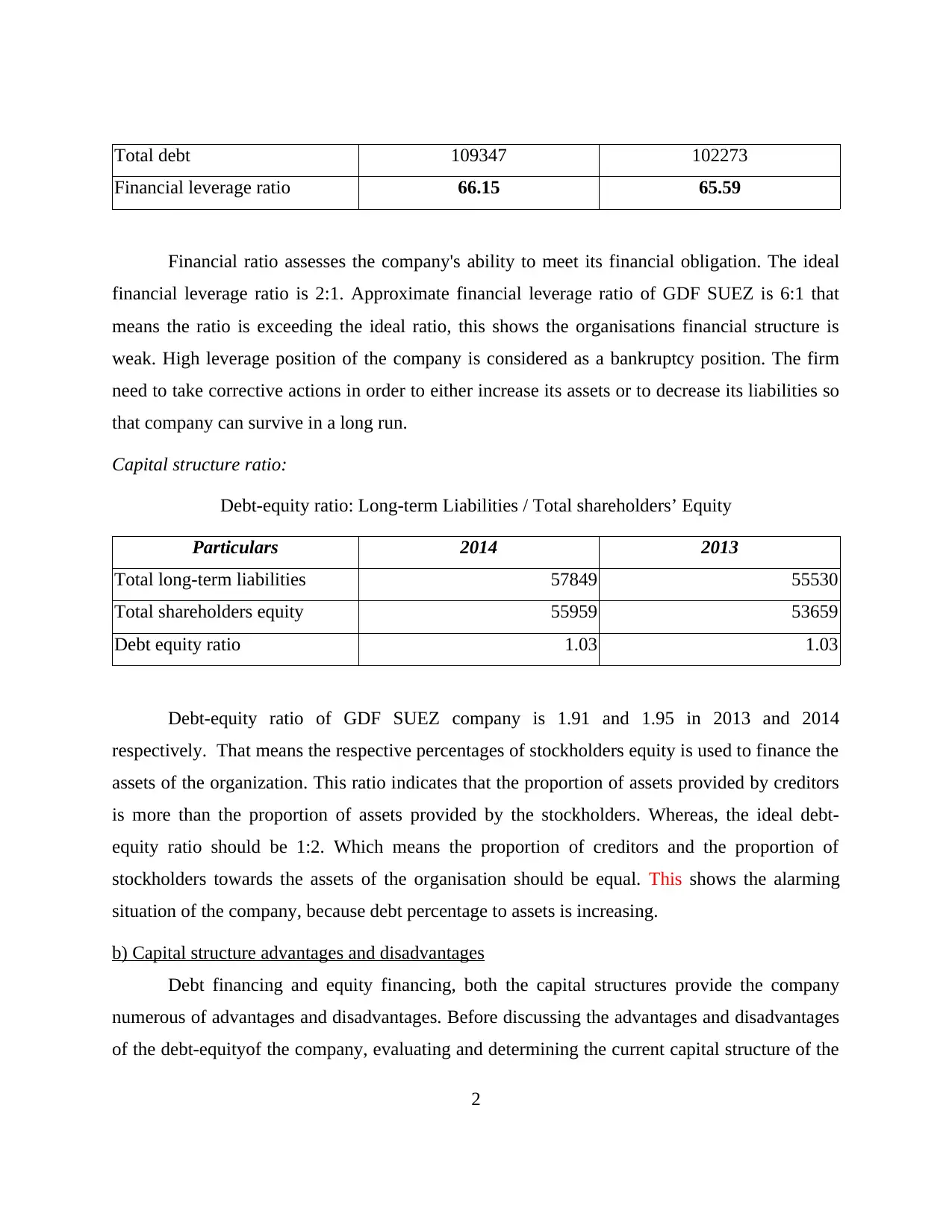
Total debt 109347 102273
Financial leverage ratio 66.15 65.59
Financial ratio assesses the company's ability to meet its financial obligation. The ideal
financial leverage ratio is 2:1. Approximate financial leverage ratio of GDF SUEZ is 6:1 that
means the ratio is exceeding the ideal ratio, this shows the organisations financial structure is
weak. High leverage position of the company is considered as a bankruptcy position. The firm
need to take corrective actions in order to either increase its assets or to decrease its liabilities so
that company can survive in a long run.
Capital structure ratio:
Debt-equity ratio: Long-term Liabilities / Total shareholders’ Equity
Particulars 2014 2013
Total long-term liabilities 57849 55530
Total shareholders equity 55959 53659
Debt equity ratio 1.03 1.03
Debt-equity ratio of GDF SUEZ company is 1.91 and 1.95 in 2013 and 2014
respectively. That means the respective percentages of stockholders equity is used to finance the
assets of the organization. This ratio indicates that the proportion of assets provided by creditors
is more than the proportion of assets provided by the stockholders. Whereas, the ideal debt-
equity ratio should be 1:2. Which means the proportion of creditors and the proportion of
stockholders towards the assets of the organisation should be equal. This shows the alarming
situation of the company, because debt percentage to assets is increasing.
b) Capital structure advantages and disadvantages
Debt financing and equity financing, both the capital structures provide the company
numerous of advantages and disadvantages. Before discussing the advantages and disadvantages
of the debt-equityof the company, evaluating and determining the current capital structure of the
2
Financial leverage ratio 66.15 65.59
Financial ratio assesses the company's ability to meet its financial obligation. The ideal
financial leverage ratio is 2:1. Approximate financial leverage ratio of GDF SUEZ is 6:1 that
means the ratio is exceeding the ideal ratio, this shows the organisations financial structure is
weak. High leverage position of the company is considered as a bankruptcy position. The firm
need to take corrective actions in order to either increase its assets or to decrease its liabilities so
that company can survive in a long run.
Capital structure ratio:
Debt-equity ratio: Long-term Liabilities / Total shareholders’ Equity
Particulars 2014 2013
Total long-term liabilities 57849 55530
Total shareholders equity 55959 53659
Debt equity ratio 1.03 1.03
Debt-equity ratio of GDF SUEZ company is 1.91 and 1.95 in 2013 and 2014
respectively. That means the respective percentages of stockholders equity is used to finance the
assets of the organization. This ratio indicates that the proportion of assets provided by creditors
is more than the proportion of assets provided by the stockholders. Whereas, the ideal debt-
equity ratio should be 1:2. Which means the proportion of creditors and the proportion of
stockholders towards the assets of the organisation should be equal. This shows the alarming
situation of the company, because debt percentage to assets is increasing.
b) Capital structure advantages and disadvantages
Debt financing and equity financing, both the capital structures provide the company
numerous of advantages and disadvantages. Before discussing the advantages and disadvantages
of the debt-equityof the company, evaluating and determining the current capital structure of the
2
Paraphrase This Document
Need a fresh take? Get an instant paraphrase of this document with our AI Paraphraser
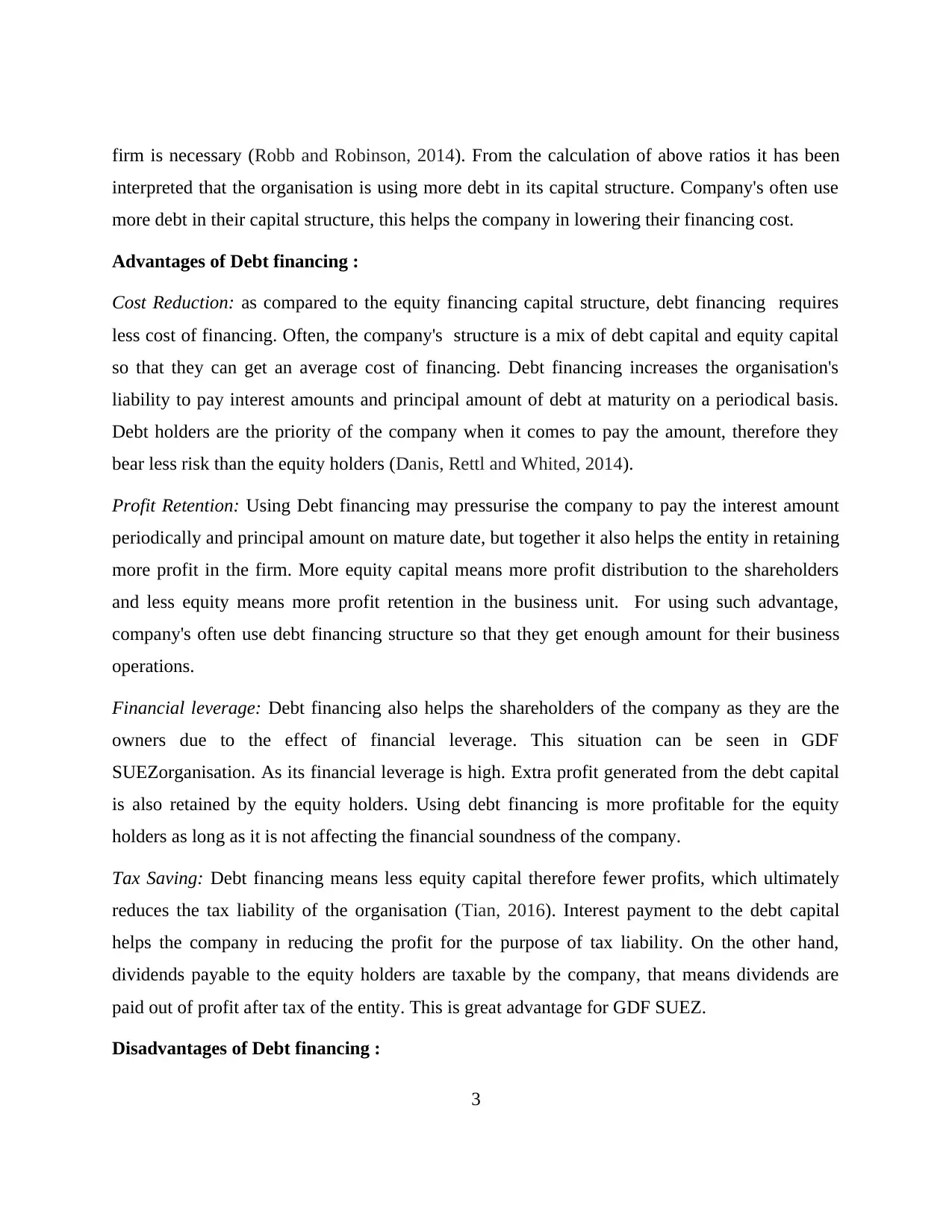
firm is necessary (Robb and Robinson, 2014). From the calculation of above ratios it has been
interpreted that the organisation is using more debt in its capital structure. Company's often use
more debt in their capital structure, this helps the company in lowering their financing cost.
Advantages of Debt financing :
Cost Reduction: as compared to the equity financing capital structure, debt financing requires
less cost of financing. Often, the company's structure is a mix of debt capital and equity capital
so that they can get an average cost of financing. Debt financing increases the organisation's
liability to pay interest amounts and principal amount of debt at maturity on a periodical basis.
Debt holders are the priority of the company when it comes to pay the amount, therefore they
bear less risk than the equity holders (Danis, Rettl and Whited, 2014).
Profit Retention: Using Debt financing may pressurise the company to pay the interest amount
periodically and principal amount on mature date, but together it also helps the entity in retaining
more profit in the firm. More equity capital means more profit distribution to the shareholders
and less equity means more profit retention in the business unit. For using such advantage,
company's often use debt financing structure so that they get enough amount for their business
operations.
Financial leverage: Debt financing also helps the shareholders of the company as they are the
owners due to the effect of financial leverage. This situation can be seen in GDF
SUEZorganisation. As its financial leverage is high. Extra profit generated from the debt capital
is also retained by the equity holders. Using debt financing is more profitable for the equity
holders as long as it is not affecting the financial soundness of the company.
Tax Saving: Debt financing means less equity capital therefore fewer profits, which ultimately
reduces the tax liability of the organisation (Tian, 2016). Interest payment to the debt capital
helps the company in reducing the profit for the purpose of tax liability. On the other hand,
dividends payable to the equity holders are taxable by the company, that means dividends are
paid out of profit after tax of the entity. This is great advantage for GDF SUEZ.
Disadvantages of Debt financing :
3
interpreted that the organisation is using more debt in its capital structure. Company's often use
more debt in their capital structure, this helps the company in lowering their financing cost.
Advantages of Debt financing :
Cost Reduction: as compared to the equity financing capital structure, debt financing requires
less cost of financing. Often, the company's structure is a mix of debt capital and equity capital
so that they can get an average cost of financing. Debt financing increases the organisation's
liability to pay interest amounts and principal amount of debt at maturity on a periodical basis.
Debt holders are the priority of the company when it comes to pay the amount, therefore they
bear less risk than the equity holders (Danis, Rettl and Whited, 2014).
Profit Retention: Using Debt financing may pressurise the company to pay the interest amount
periodically and principal amount on mature date, but together it also helps the entity in retaining
more profit in the firm. More equity capital means more profit distribution to the shareholders
and less equity means more profit retention in the business unit. For using such advantage,
company's often use debt financing structure so that they get enough amount for their business
operations.
Financial leverage: Debt financing also helps the shareholders of the company as they are the
owners due to the effect of financial leverage. This situation can be seen in GDF
SUEZorganisation. As its financial leverage is high. Extra profit generated from the debt capital
is also retained by the equity holders. Using debt financing is more profitable for the equity
holders as long as it is not affecting the financial soundness of the company.
Tax Saving: Debt financing means less equity capital therefore fewer profits, which ultimately
reduces the tax liability of the organisation (Tian, 2016). Interest payment to the debt capital
helps the company in reducing the profit for the purpose of tax liability. On the other hand,
dividends payable to the equity holders are taxable by the company, that means dividends are
paid out of profit after tax of the entity. This is great advantage for GDF SUEZ.
Disadvantages of Debt financing :
3
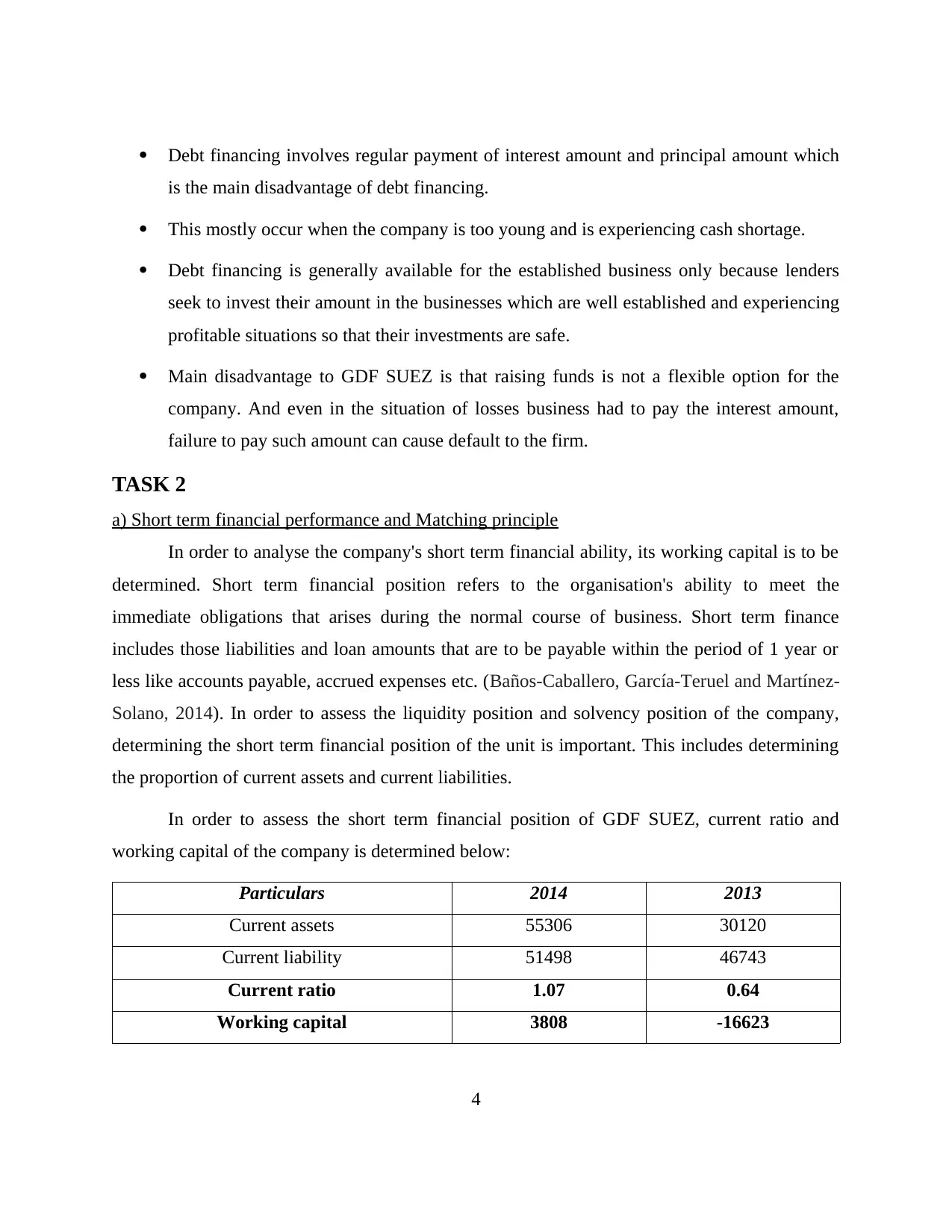
Debt financing involves regular payment of interest amount and principal amount which
is the main disadvantage of debt financing.
This mostly occur when the company is too young and is experiencing cash shortage.
Debt financing is generally available for the established business only because lenders
seek to invest their amount in the businesses which are well established and experiencing
profitable situations so that their investments are safe.
Main disadvantage to GDF SUEZ is that raising funds is not a flexible option for the
company. And even in the situation of losses business had to pay the interest amount,
failure to pay such amount can cause default to the firm.
TASK 2
a) Short term financial performance and Matching principle
In order to analyse the company's short term financial ability, its working capital is to be
determined. Short term financial position refers to the organisation's ability to meet the
immediate obligations that arises during the normal course of business. Short term finance
includes those liabilities and loan amounts that are to be payable within the period of 1 year or
less like accounts payable, accrued expenses etc. (Baños-Caballero, García-Teruel and Martínez-
Solano, 2014). In order to assess the liquidity position and solvency position of the company,
determining the short term financial position of the unit is important. This includes determining
the proportion of current assets and current liabilities.
In order to assess the short term financial position of GDF SUEZ, current ratio and
working capital of the company is determined below:
Particulars 2014 2013
Current assets 55306 30120
Current liability 51498 46743
Current ratio 1.07 0.64
Working capital 3808 -16623
4
is the main disadvantage of debt financing.
This mostly occur when the company is too young and is experiencing cash shortage.
Debt financing is generally available for the established business only because lenders
seek to invest their amount in the businesses which are well established and experiencing
profitable situations so that their investments are safe.
Main disadvantage to GDF SUEZ is that raising funds is not a flexible option for the
company. And even in the situation of losses business had to pay the interest amount,
failure to pay such amount can cause default to the firm.
TASK 2
a) Short term financial performance and Matching principle
In order to analyse the company's short term financial ability, its working capital is to be
determined. Short term financial position refers to the organisation's ability to meet the
immediate obligations that arises during the normal course of business. Short term finance
includes those liabilities and loan amounts that are to be payable within the period of 1 year or
less like accounts payable, accrued expenses etc. (Baños-Caballero, García-Teruel and Martínez-
Solano, 2014). In order to assess the liquidity position and solvency position of the company,
determining the short term financial position of the unit is important. This includes determining
the proportion of current assets and current liabilities.
In order to assess the short term financial position of GDF SUEZ, current ratio and
working capital of the company is determined below:
Particulars 2014 2013
Current assets 55306 30120
Current liability 51498 46743
Current ratio 1.07 0.64
Working capital 3808 -16623
4
⊘ This is a preview!⊘
Do you want full access?
Subscribe today to unlock all pages.

Trusted by 1+ million students worldwide
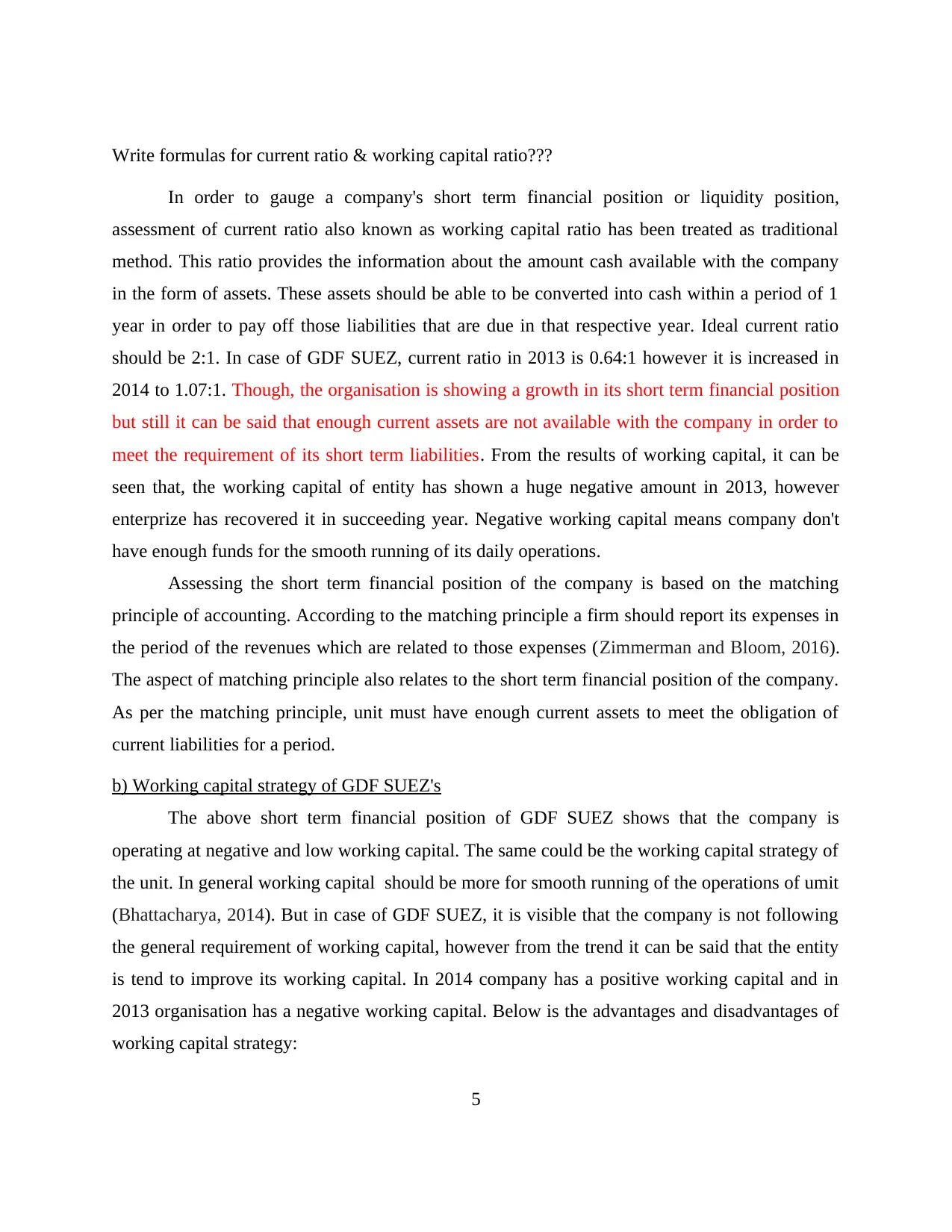
Write formulas for current ratio & working capital ratio???
In order to gauge a company's short term financial position or liquidity position,
assessment of current ratio also known as working capital ratio has been treated as traditional
method. This ratio provides the information about the amount cash available with the company
in the form of assets. These assets should be able to be converted into cash within a period of 1
year in order to pay off those liabilities that are due in that respective year. Ideal current ratio
should be 2:1. In case of GDF SUEZ, current ratio in 2013 is 0.64:1 however it is increased in
2014 to 1.07:1. Though, the organisation is showing a growth in its short term financial position
but still it can be said that enough current assets are not available with the company in order to
meet the requirement of its short term liabilities. From the results of working capital, it can be
seen that, the working capital of entity has shown a huge negative amount in 2013, however
enterprize has recovered it in succeeding year. Negative working capital means company don't
have enough funds for the smooth running of its daily operations.
Assessing the short term financial position of the company is based on the matching
principle of accounting. According to the matching principle a firm should report its expenses in
the period of the revenues which are related to those expenses (Zimmerman and Bloom, 2016).
The aspect of matching principle also relates to the short term financial position of the company.
As per the matching principle, unit must have enough current assets to meet the obligation of
current liabilities for a period.
b) Working capital strategy of GDF SUEZ's
The above short term financial position of GDF SUEZ shows that the company is
operating at negative and low working capital. The same could be the working capital strategy of
the unit. In general working capital should be more for smooth running of the operations of umit
(Bhattacharya, 2014). But in case of GDF SUEZ, it is visible that the company is not following
the general requirement of working capital, however from the trend it can be said that the entity
is tend to improve its working capital. In 2014 company has a positive working capital and in
2013 organisation has a negative working capital. Below is the advantages and disadvantages of
working capital strategy:
5
In order to gauge a company's short term financial position or liquidity position,
assessment of current ratio also known as working capital ratio has been treated as traditional
method. This ratio provides the information about the amount cash available with the company
in the form of assets. These assets should be able to be converted into cash within a period of 1
year in order to pay off those liabilities that are due in that respective year. Ideal current ratio
should be 2:1. In case of GDF SUEZ, current ratio in 2013 is 0.64:1 however it is increased in
2014 to 1.07:1. Though, the organisation is showing a growth in its short term financial position
but still it can be said that enough current assets are not available with the company in order to
meet the requirement of its short term liabilities. From the results of working capital, it can be
seen that, the working capital of entity has shown a huge negative amount in 2013, however
enterprize has recovered it in succeeding year. Negative working capital means company don't
have enough funds for the smooth running of its daily operations.
Assessing the short term financial position of the company is based on the matching
principle of accounting. According to the matching principle a firm should report its expenses in
the period of the revenues which are related to those expenses (Zimmerman and Bloom, 2016).
The aspect of matching principle also relates to the short term financial position of the company.
As per the matching principle, unit must have enough current assets to meet the obligation of
current liabilities for a period.
b) Working capital strategy of GDF SUEZ's
The above short term financial position of GDF SUEZ shows that the company is
operating at negative and low working capital. The same could be the working capital strategy of
the unit. In general working capital should be more for smooth running of the operations of umit
(Bhattacharya, 2014). But in case of GDF SUEZ, it is visible that the company is not following
the general requirement of working capital, however from the trend it can be said that the entity
is tend to improve its working capital. In 2014 company has a positive working capital and in
2013 organisation has a negative working capital. Below is the advantages and disadvantages of
working capital strategy:
5
Paraphrase This Document
Need a fresh take? Get an instant paraphrase of this document with our AI Paraphraser
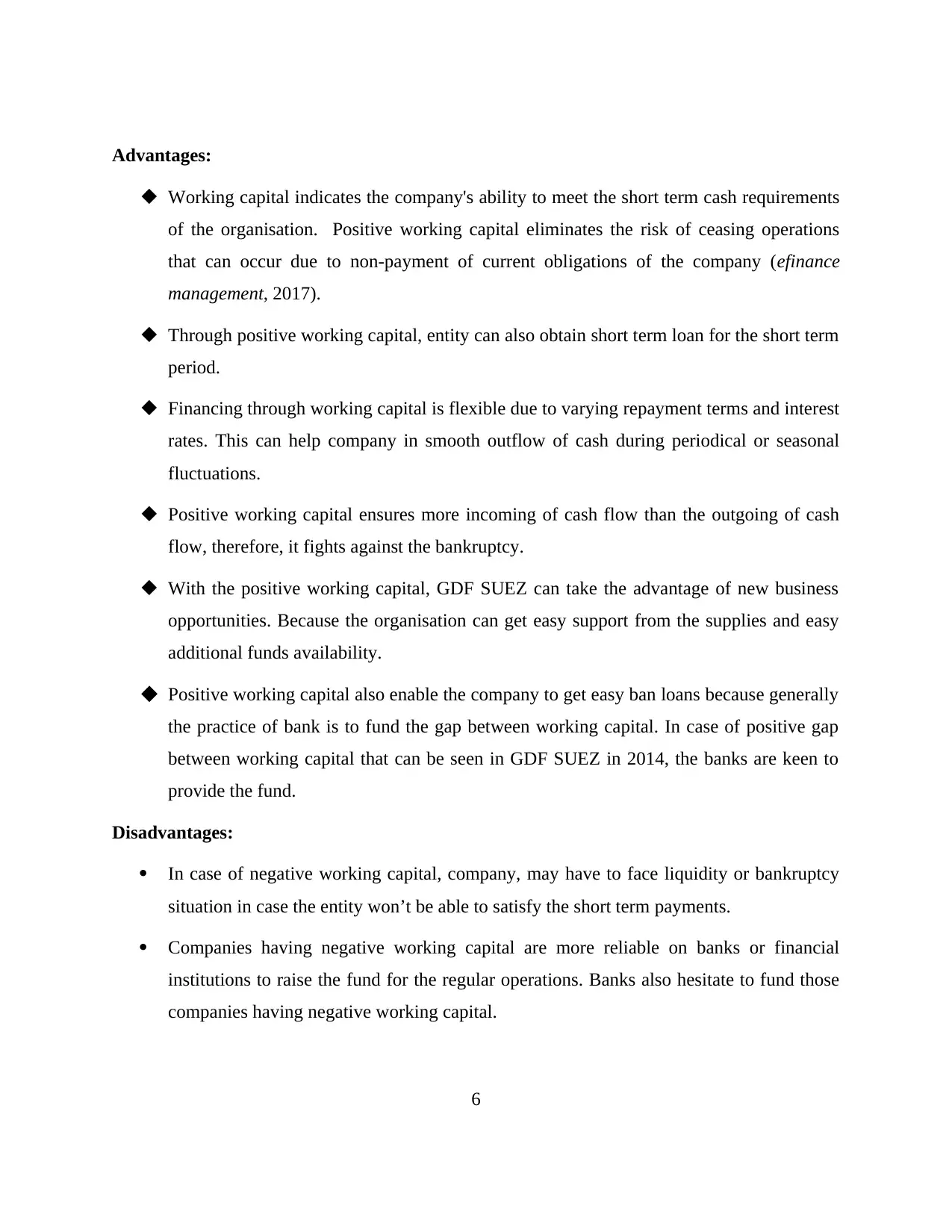
Advantages:
Working capital indicates the company's ability to meet the short term cash requirements
of the organisation. Positive working capital eliminates the risk of ceasing operations
that can occur due to non-payment of current obligations of the company (efinance
management, 2017).
Through positive working capital, entity can also obtain short term loan for the short term
period.
Financing through working capital is flexible due to varying repayment terms and interest
rates. This can help company in smooth outflow of cash during periodical or seasonal
fluctuations.
Positive working capital ensures more incoming of cash flow than the outgoing of cash
flow, therefore, it fights against the bankruptcy.
With the positive working capital, GDF SUEZ can take the advantage of new business
opportunities. Because the organisation can get easy support from the supplies and easy
additional funds availability.
Positive working capital also enable the company to get easy ban loans because generally
the practice of bank is to fund the gap between working capital. In case of positive gap
between working capital that can be seen in GDF SUEZ in 2014, the banks are keen to
provide the fund.
Disadvantages:
In case of negative working capital, company, may have to face liquidity or bankruptcy
situation in case the entity won’t be able to satisfy the short term payments.
Companies having negative working capital are more reliable on banks or financial
institutions to raise the fund for the regular operations. Banks also hesitate to fund those
companies having negative working capital.
6
Working capital indicates the company's ability to meet the short term cash requirements
of the organisation. Positive working capital eliminates the risk of ceasing operations
that can occur due to non-payment of current obligations of the company (efinance
management, 2017).
Through positive working capital, entity can also obtain short term loan for the short term
period.
Financing through working capital is flexible due to varying repayment terms and interest
rates. This can help company in smooth outflow of cash during periodical or seasonal
fluctuations.
Positive working capital ensures more incoming of cash flow than the outgoing of cash
flow, therefore, it fights against the bankruptcy.
With the positive working capital, GDF SUEZ can take the advantage of new business
opportunities. Because the organisation can get easy support from the supplies and easy
additional funds availability.
Positive working capital also enable the company to get easy ban loans because generally
the practice of bank is to fund the gap between working capital. In case of positive gap
between working capital that can be seen in GDF SUEZ in 2014, the banks are keen to
provide the fund.
Disadvantages:
In case of negative working capital, company, may have to face liquidity or bankruptcy
situation in case the entity won’t be able to satisfy the short term payments.
Companies having negative working capital are more reliable on banks or financial
institutions to raise the fund for the regular operations. Banks also hesitate to fund those
companies having negative working capital.
6
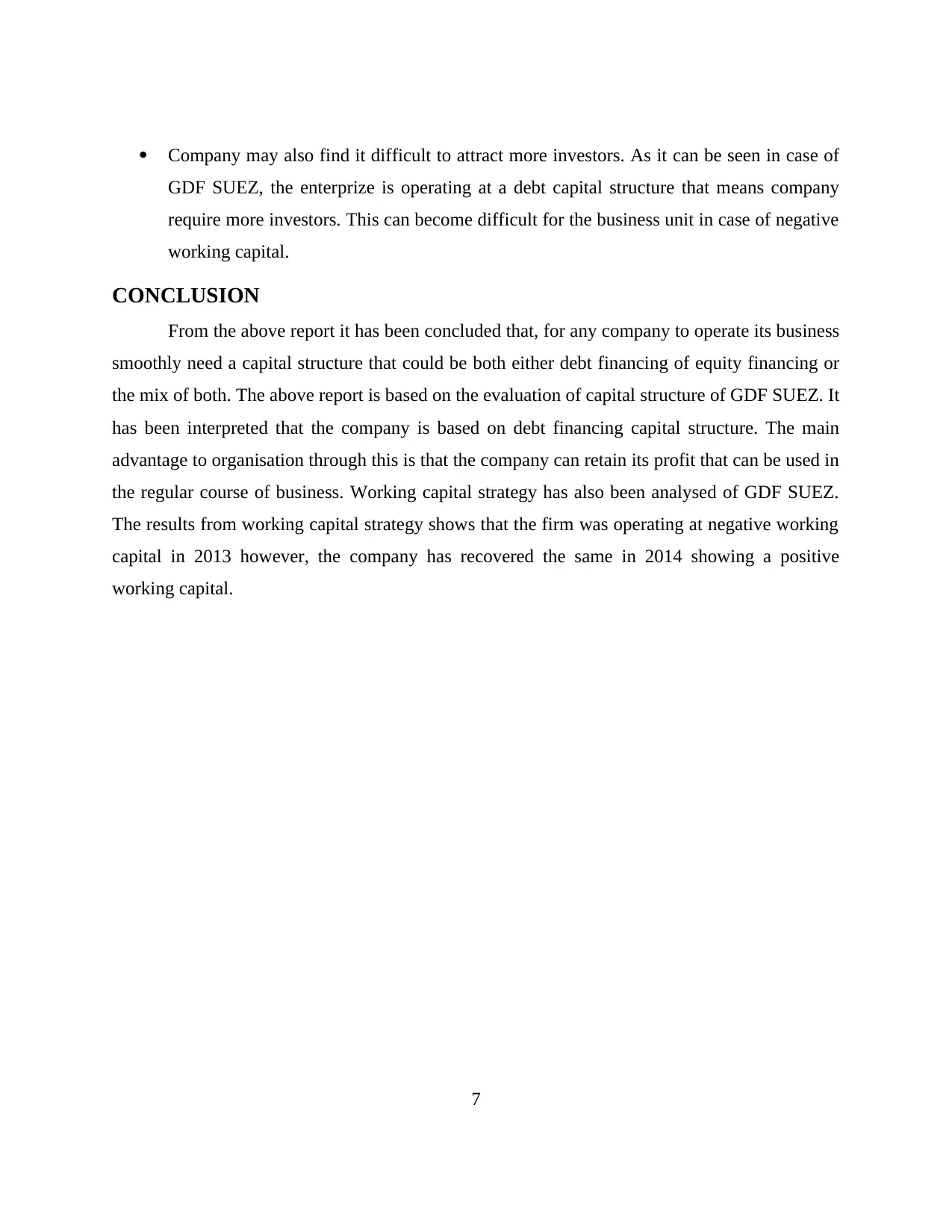
Company may also find it difficult to attract more investors. As it can be seen in case of
GDF SUEZ, the enterprize is operating at a debt capital structure that means company
require more investors. This can become difficult for the business unit in case of negative
working capital.
CONCLUSION
From the above report it has been concluded that, for any company to operate its business
smoothly need a capital structure that could be both either debt financing of equity financing or
the mix of both. The above report is based on the evaluation of capital structure of GDF SUEZ. It
has been interpreted that the company is based on debt financing capital structure. The main
advantage to organisation through this is that the company can retain its profit that can be used in
the regular course of business. Working capital strategy has also been analysed of GDF SUEZ.
The results from working capital strategy shows that the firm was operating at negative working
capital in 2013 however, the company has recovered the same in 2014 showing a positive
working capital.
7
GDF SUEZ, the enterprize is operating at a debt capital structure that means company
require more investors. This can become difficult for the business unit in case of negative
working capital.
CONCLUSION
From the above report it has been concluded that, for any company to operate its business
smoothly need a capital structure that could be both either debt financing of equity financing or
the mix of both. The above report is based on the evaluation of capital structure of GDF SUEZ. It
has been interpreted that the company is based on debt financing capital structure. The main
advantage to organisation through this is that the company can retain its profit that can be used in
the regular course of business. Working capital strategy has also been analysed of GDF SUEZ.
The results from working capital strategy shows that the firm was operating at negative working
capital in 2013 however, the company has recovered the same in 2014 showing a positive
working capital.
7
⊘ This is a preview!⊘
Do you want full access?
Subscribe today to unlock all pages.

Trusted by 1+ million students worldwide
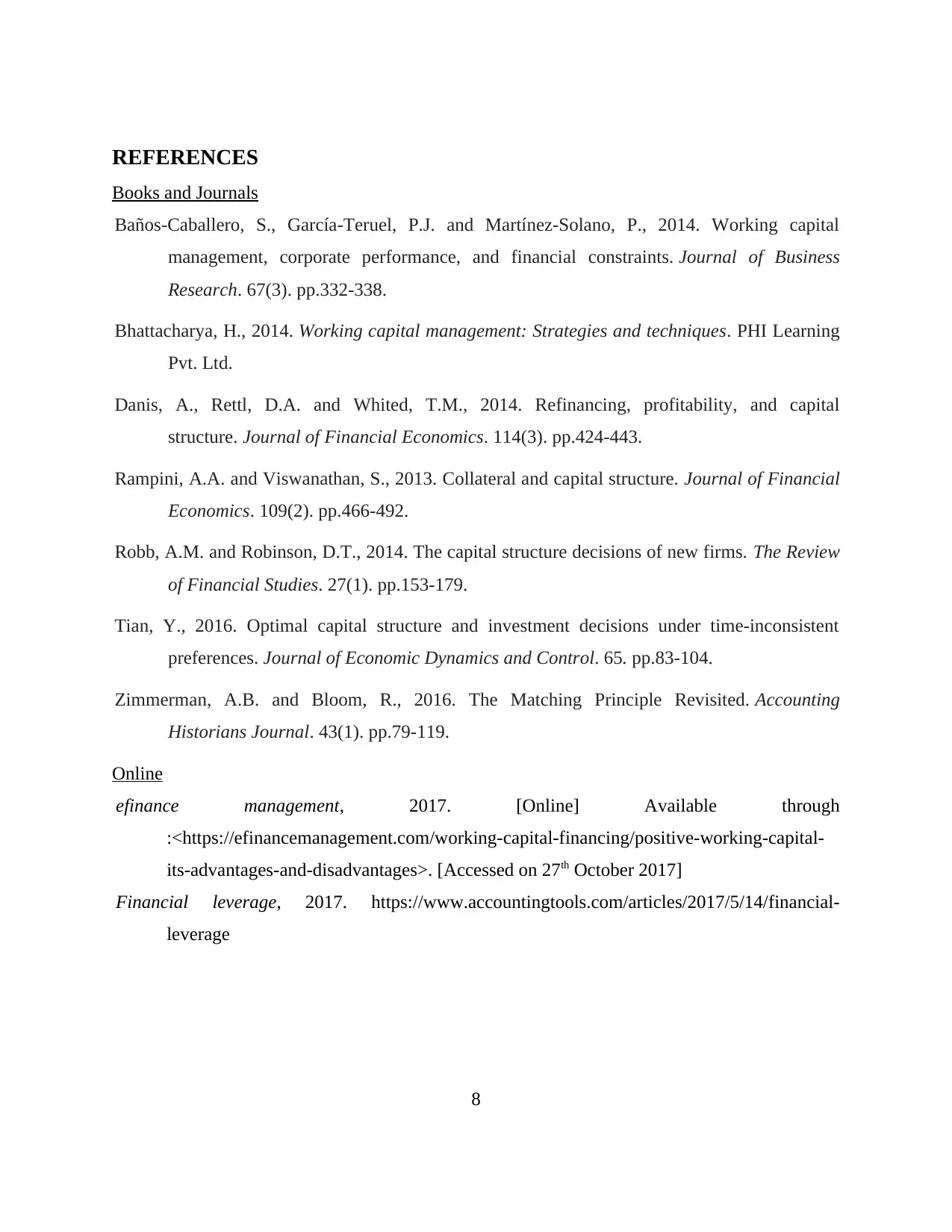
REFERENCES
Books and Journals
Baños-Caballero, S., García-Teruel, P.J. and Martínez-Solano, P., 2014. Working capital
management, corporate performance, and financial constraints. Journal of Business
Research. 67(3). pp.332-338.
Bhattacharya, H., 2014. Working capital management: Strategies and techniques. PHI Learning
Pvt. Ltd.
Danis, A., Rettl, D.A. and Whited, T.M., 2014. Refinancing, profitability, and capital
structure. Journal of Financial Economics. 114(3). pp.424-443.
Rampini, A.A. and Viswanathan, S., 2013. Collateral and capital structure. Journal of Financial
Economics. 109(2). pp.466-492.
Robb, A.M. and Robinson, D.T., 2014. The capital structure decisions of new firms. The Review
of Financial Studies. 27(1). pp.153-179.
Tian, Y., 2016. Optimal capital structure and investment decisions under time-inconsistent
preferences. Journal of Economic Dynamics and Control. 65. pp.83-104.
Zimmerman, A.B. and Bloom, R., 2016. The Matching Principle Revisited. Accounting
Historians Journal. 43(1). pp.79-119.
Online
efinance management, 2017. [Online] Available through
:<https://efinancemanagement.com/working-capital-financing/positive-working-capital-
its-advantages-and-disadvantages>. [Accessed on 27th October 2017]
Financial leverage, 2017. https://www.accountingtools.com/articles/2017/5/14/financial-
leverage
8
Books and Journals
Baños-Caballero, S., García-Teruel, P.J. and Martínez-Solano, P., 2014. Working capital
management, corporate performance, and financial constraints. Journal of Business
Research. 67(3). pp.332-338.
Bhattacharya, H., 2014. Working capital management: Strategies and techniques. PHI Learning
Pvt. Ltd.
Danis, A., Rettl, D.A. and Whited, T.M., 2014. Refinancing, profitability, and capital
structure. Journal of Financial Economics. 114(3). pp.424-443.
Rampini, A.A. and Viswanathan, S., 2013. Collateral and capital structure. Journal of Financial
Economics. 109(2). pp.466-492.
Robb, A.M. and Robinson, D.T., 2014. The capital structure decisions of new firms. The Review
of Financial Studies. 27(1). pp.153-179.
Tian, Y., 2016. Optimal capital structure and investment decisions under time-inconsistent
preferences. Journal of Economic Dynamics and Control. 65. pp.83-104.
Zimmerman, A.B. and Bloom, R., 2016. The Matching Principle Revisited. Accounting
Historians Journal. 43(1). pp.79-119.
Online
efinance management, 2017. [Online] Available through
:<https://efinancemanagement.com/working-capital-financing/positive-working-capital-
its-advantages-and-disadvantages>. [Accessed on 27th October 2017]
Financial leverage, 2017. https://www.accountingtools.com/articles/2017/5/14/financial-
leverage
8
1 out of 10
Related Documents
Your All-in-One AI-Powered Toolkit for Academic Success.
+13062052269
info@desklib.com
Available 24*7 on WhatsApp / Email
![[object Object]](/_next/static/media/star-bottom.7253800d.svg)
Unlock your academic potential
Copyright © 2020–2025 A2Z Services. All Rights Reserved. Developed and managed by ZUCOL.





